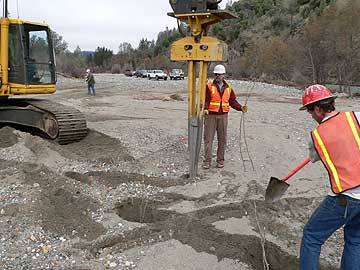
|
|

|
|
Revegetation is the art and science of re-establishing healthy native plant communities where they have been lost or weakened due to fire, erosion, construction or displaced by invasions of non-native plants. Here the challenge is to restore native plants and seeds appropriate for the location. TRRP plans call for seeding then mulching upland areas (those not inundated by high flow events) to minimize erosion and weed invasion. Since this is where the TRRP placed much of the sediment it moved from the river floodplain, it wants to convert and maintain these areas in a more native vegetative condition than existed prior to the project. This is done using techniques intended to give new plantings a head-start so they can quickly out-compete weeds and undesirable non-native plants like star thistle, tree of heaven and Dalmatian toadflax. Wheat seeds and native grass seeds will be spread, then weed-free straw applied as mulch. The mulch protects newly-sown seeds while it helps limit the return of local weeds by blocking those seeds from reaching soil. The wheat seed will grow rapidly the first year or two, taking up the space weeds need to get a foothold and then dies off. This assists native grasses to become established as the long-term seed source and dominant groundcover. Planting will be done by hand or a straw blower may be used to spread mulch. Along the river corridor, emphasis will be on planting certain riverine species which are native to the area but have not remained dominant since the Trinity River was dammed and its flows regulated. For instance, the present dominant riverine species, the narrow-leaf willow, will not be re-planted. Instead, cuttings from black cottonwood and arroyo, red, and shiny species of willow trees will be planted. In addition, desirable trees were left standing in areas of the rehabilitation work so that they might serve as local seed sources. In some places, roots from old willows will send up shoots for rapid regeneration of native riparian vegetation. Most new tree plantings will be done with “pole-cuttings.” These are trimmed tree limbs that have the potential to quickly sprout roots. These will be planted using a device called a “stinger.” The stinger, a special attachment on the head of an excavator, can force a hole down to about six feet deep in the rocky floodplain, allowing insertion of a pole-cutting into the water table. This ensures maximum survival, even in dry conditions. Another valuable step of rehabilitation work in this project has been the placement of large intact logs on the floodplain and on the river’s edge. The purpose of these logs, technically referred to as “large wood debris,” is to provide structural integrity to the river ecosystem and critical habitat for salmonids. It is important these logs be left undisturbed by the public. In time, these pieces of wood will help create and maintain pools and backwaters that salmonids use for foraging, overwintering, refuge from predators, and for rearing habitat. When these trees become submerged they provide important slow water habitat for small fish.
Return to the Trinity County RCD Home Page
|


